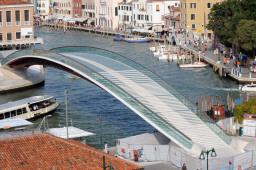A controversial new high-tech bridge over Venice's Grand Canal has been opened in the dead of night after the city council was forced to cancel its official inauguration over protests from local politicians.
Surprised tourists and residents were the first to cross Constitution Bridge, designed by world-famous Spanish architect Santiago Calatrava, when workmen pulled away barriers a few minutes before midnight.
Venice Mayor Massimo Cacciari was present to thank the workmen, who broke open bottles and toasted the bridge with passers-by.
The city council's public works chief, Mara Rumiz, described the bridge as ''beautiful''.
''This bridge brings to Venice a great work of contemporary architecture: it's a stimulus for the city to not only look at its splendid past, but to live fully in the present and to give itself a future,'' she said.
In August Cacciari cancelled a public inauguration ceremony with Italian President Giorgio Napolitano after the local branch of the right-wing National Alliance party - a long-running critic of the bridge - said it would disrupt the event.
The bridge has been dogged by controversy because of cost overruns, concerns about its stability and an initial lack of access for the disabled.
An original price tag of four million euros in the mid-1990s has swelled to what the council says is more than 11 million.
The National Alliance claims that the final cost could be twice that due to legal disputes with the construction company.
Calatrava, who has described the work as his ''most beautiful bridge'' and ''an act of love for Venice and for Italian civilization in general'', said earlier this month that the the overruns had ''nothing to do'' with him but were caused by an initial underestimation of costs.
He also noted that the need for disabled access, which is costing an extra million, had not been raised at the planning stage.
The council has pledged to install an automatic lift for people with mobility problems in the next few months.
In the meantime, the disabled can travel free on the ferry which, like the bridge, links Venice's railway station with Piazzale Roma, a car, bus and ferry terminal on the opposite side of the Grand Canal.
First planned in 1996, the bridge was installed two years late last summer amid fears that the canal banks wouldn't be able to hold it up properly.
In February Cacciari had to dismiss fears that the bridge might be shaky after a local newspaper quoted project chief Roberto Casarin as saying it had moved ''about a centimetre'' in a load-bearing trial.
Other alterations to the original plan included the decision to add stairs, in order to make the structure more visible to tourists, and to use two kinds of stone instead of one.
The sleek arc of steel accessed by a flight of glass steps spans 94 metres from one bank to the other.
The bridge is the fourth over the lagoon city's Grand Canal and the city's first new bridge in 70 years.
Calatrava's other trademark buildings include the stadium for the Athens Olympics, an auditorium and sealife centre in his native Valencia and the Milwaukee Museum of Fine Arts.
He has also designed three bridges over the Trinity River in Dallas and the Chicago Spire, set to be the tallest building in North America.
The bridge was named after the Italian Constitution earlier this month after its 60th anniversary.










